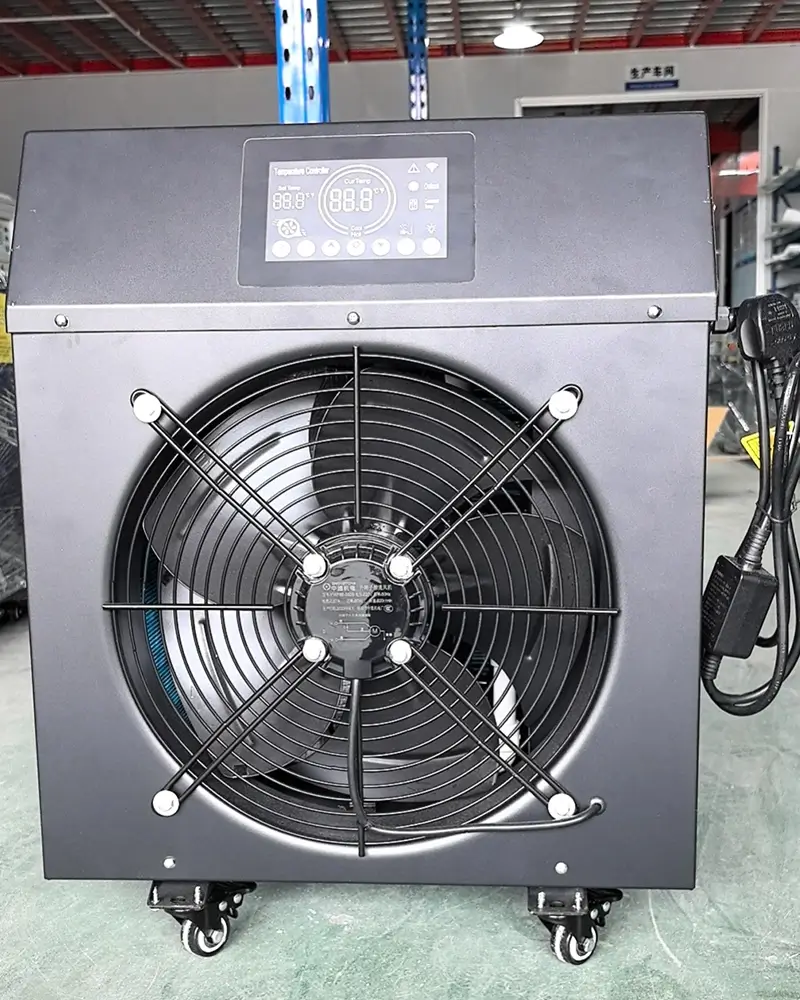Por que a água deve circular através de um resfriador?
Por que a água deve circular através de um resfriador?
A circulação da água ajuda a absorver e remover o calor gerado pela máquina, Garantir controle consistente de temperatura e eliminar pontos quentes localizados, o que melhora a eficiência da transferência de calor e reduz a tensão térmica no equipamento.
Compreender a importância da circulação da água para manter a qualidade da água e prevenir a escala e o acúmulo de detritos pode ser benéfico. Ao entender o fluxo de água eficiente, você pode melhorar Refriador de água confiabilidade, reduzir o consumo de energia operacional, prolongar a vida útil do equipamento e garantir o desempenho ideal e a relação custo -benefício.
Como o ciclo da água impede o superaquecimento do chiller?
Sem ampla circulação de água, O calor se acumularia, causando níveis elevados de temperatura que podem fazer com que os dispositivos falhem ou funcionem ineficientemente.
A circulação de água confiável garante que o calor coletado pela água seja continuamente afastado do equipamento para o Refriador de água. O resfriador de água então dissipa esse calor na configuração, Freqüentemente, utilizando uma torre de resfriamento ou outros sistemas de troca de calor. Essa remoção contínua do calor mantém o equipamento em temperaturas operacionais ideais, impedindo assim os efeitos negativos do superaquecimento.
Além disso, A circulação constante de água ajuda a manter uma temperatura estável ao redor do equipamento. Alterações de temperatura podem desencadear o estresse térmico, que pode deteriorar materiais e componentes ao longo do tempo. Garantindo um fluxo estável de água, O sistema de resfriador de água mantém a temperatura dentro de uma faixa segura, protegendo assim o equipamento por danos e prolongando sua vida operacional.
Outro elemento vital é o papel da circulação da água na remoção de pontos de acesso. Hotspots são áreas localizadas de alta temperatura que podem criar quando houver resfriamento inadequado. Esses pontos podem resultar em expansão térmica desigual, estresse mecânico, e possível falha do equipamento. A circulação constante e eficiente da água ajuda a dispersar o efeito de resfriamento igualmente em todas as superfícies, impedindo o desenvolvimento de tais pontos de acesso.
Por que a água deve ser divulgada através de um chiller?
A água deve circular através de um chiller para absorver e transportar o calor para longe do sistema. Este processo é essencial para manter faixas de temperatura ideais, melhorando a eficiência, e impedir possíveis falhas do sistema devido ao superaquecimento.
Como os chillers impedem o superaquecimento do equipamento?
A circulação de água absorve e remove o calor gerado por máquinas e processos industriais. Sem circulação adequada de água, O calor se acumularia, levando ao aumento de temperaturas que podem fazer com que o equipamento falhe ou opere ineficientemente.
Qual é o impacto da circulação da água no consumo de energia?
A circulação eficiente da água influencia diretamente a quantidade de energia necessária para manter o melhor desempenho de resfriamento. Garantindo que a água se mova continuamente pelo chiller, Os processos de transferência de calor se tornam mais eficazes, reduzindo a necessidade de o chiller trabalhar mais e consumir mais energia.
Como a circulação da água aumenta a transferência de calor e mantém o desempenho consistente de resfriamento em sistemas de resfriamento?
A circulação eficaz da água garante uma transferência de calor consistente e eficiente do refrigerante para o meio de resfriamento. Este processo impede pontos de acesso localizado e mantém temperaturas uniformes, que são cruciais para o desempenho e eficiência ideais do chiller. A circulação consistente da água também evita desequilíbrios de temperatura e estresse térmico nos componentes do sistema, garantindo uma operação eficiente e confiável.
Por que a qualidade da água é importante nos sistemas de circulação de chiller?
Manter água de alta qualidade em sistemas de circulação de resfriador é crucial para prevenir problemas como a formação de escala, corrosão, e crescimento biológico. A circulação adequada da água ajuda a minimizar esses contaminantes, garantir o desempenho ideal e a longevidade do equipamento.
Como a qualidade da água pode ser mantida em sistemas de circulação de resfriadores?
Manter a qualidade da água em sistemas de circulação de resfriador envolve o uso de métodos de tratamento de água apropriados, such as chemical inhibitors to prevent scale and corrosion, and biocides to control biological growth. Regular monitoring and testing of water parameters, along with routine maintenance like cleaning and flushing the system, are also essential.
No entanto, if you choose the Harman N chiller, you can be assured of superior water quality. O Harman N water chiller is equipped with ozone, UV technology, and dual-layer filters, providing an extra layer of protection. This advanced system ensures that you can enjoy your ice bath with complete peace of mind, knowing the water is always clean and safe.
O negócio diante dele
Por que a água deve circular através de um resfriador?
A circulação da água ajuda a absorver e remover o calor gerado pela máquina, Garantir controle consistente de temperatura e eliminar pontos quentes localizados, o que melhora a eficiência da transferência de calor e reduz a tensão térmica no equipamento.
Compreender a importância da circulação da água para manter a qualidade da água e prevenir a escala e o acúmulo de detritos pode ser benéfico. Ao entender o fluxo de água eficiente, você pode melhorar Refriador de água confiabilidade, reduzir o consumo de energia operacional, prolongar a vida útil do equipamento e garantir o desempenho ideal e a relação custo -benefício.
Como o ciclo da água impede o superaquecimento do chiller?
Sem ampla circulação de água, O calor se acumularia, causando níveis elevados de temperatura que podem fazer com que os dispositivos falhem ou funcionem ineficientemente.
A circulação de água confiável garante que o calor coletado pela água seja continuamente afastado do equipamento para o Refriador de água. O resfriador de água então dissipa esse calor na configuração, Freqüentemente, utilizando uma torre de resfriamento ou outros sistemas de troca de calor. Essa remoção contínua do calor mantém o equipamento em temperaturas operacionais ideais, impedindo assim os efeitos negativos do superaquecimento.
Além disso, A circulação constante de água ajuda a manter uma temperatura estável ao redor do equipamento. Alterações de temperatura podem desencadear o estresse térmico, que pode deteriorar materiais e componentes ao longo do tempo. Garantindo um fluxo estável de água, O sistema de resfriador de água mantém a temperatura dentro de uma faixa segura, protegendo assim o equipamento por danos e prolongando sua vida operacional.
Outro elemento vital é o papel da circulação da água na remoção de pontos de acesso. Hotspots são áreas localizadas de alta temperatura que podem criar quando houver resfriamento inadequado. Esses pontos podem resultar em expansão térmica desigual, estresse mecânico, e possível falha do equipamento. A circulação constante e eficiente da água ajuda a dispersar o efeito de resfriamento igualmente em todas as superfícies, impedindo o desenvolvimento de tais pontos de acesso.
Por que a água deve ser divulgada através de um chiller?
A água deve circular através de um chiller para absorver e transportar o calor para longe do sistema. Este processo é essencial para manter faixas de temperatura ideais, melhorando a eficiência, e impedir possíveis falhas do sistema devido ao superaquecimento.
Como os chillers impedem o superaquecimento do equipamento?
A circulação de água absorve e remove o calor gerado por máquinas e processos industriais. Sem circulação adequada de água, O calor se acumularia, levando ao aumento de temperaturas que podem fazer com que o equipamento falhe ou opere ineficientemente.
Qual é o impacto da circulação da água no consumo de energia?
A circulação eficiente da água influencia diretamente a quantidade de energia necessária para manter o melhor desempenho de resfriamento. Garantindo que a água se mova continuamente pelo chiller, Os processos de transferência de calor se tornam mais eficazes, reduzindo a necessidade de o chiller trabalhar mais e consumir mais energia.
Como a circulação da água aumenta a transferência de calor e mantém o desempenho consistente de resfriamento em sistemas de resfriamento?
A circulação eficaz da água garante uma transferência de calor consistente e eficiente do refrigerante para o meio de resfriamento. Este processo impede pontos de acesso localizado e mantém temperaturas uniformes, que são cruciais para o desempenho e eficiência ideais do chiller. A circulação consistente da água também evita desequilíbrios de temperatura e estresse térmico nos componentes do sistema, garantindo uma operação eficiente e confiável.
Por que a qualidade da água é importante nos sistemas de circulação de chiller?
Manter água de alta qualidade em sistemas de circulação de resfriador é crucial para prevenir problemas como a formação de escala, corrosão, e crescimento biológico. A circulação adequada da água ajuda a minimizar esses contaminantes, garantir o desempenho ideal e a longevidade do equipamento.
Como a qualidade da água pode ser mantida em sistemas de circulação de resfriadores?
Manter a qualidade da água em sistemas de circulação de resfriador envolve o uso de métodos de tratamento de água apropriados, such as chemical inhibitors to prevent scale and corrosion, and biocides to control biological growth. Regular monitoring and testing of water parameters, along with routine maintenance like cleaning and flushing the system, are also essential.
No entanto, if you choose the Harman N chiller, you can be assured of superior water quality. O Harman N water chiller is equipped with ozone, UV technology, and dual-layer filters, providing an extra layer of protection. This advanced system ensures that you can enjoy your ice bath with complete peace of mind, knowing the water is always clean and safe.
Sobre o autor

Bem-vindo ao nosso blog! Meu nome é Peter e sou o autor principal deste blog. Como praticante de recuperação esportiva e com profundos interesses e experiência.
Tenho o compromisso de apresentar conceitos complexos de maneira clara e concisa, e permitir que os leitores compreendam e apliquem melhor esse conhecimento por meio de pesquisas aprofundadas e compartilhamento de experiências.
Obrigado por ler e pelo seu apoio! Se você tiver dúvidas ou sugestões sobre algum conteúdo, sinta-se à vontade para entrar em contato comigo. Estou ansioso para compartilhar mais informações interessantes e úteis com você e crescer juntos nesta jornada de conhecimento!

